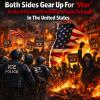
Breaking News
 BREAKING EXCLUSIVE: Kyle Rittenhouse Warns The Left Is Preparing To Stage A False Flag To Blame...
BREAKING EXCLUSIVE: Kyle Rittenhouse Warns The Left Is Preparing To Stage A False Flag To Blame...
 The Biggest Grid We Escaped (It Wasn't Power)
The Biggest Grid We Escaped (It Wasn't Power)
 Both Sides Gear Up For "War" As An Internal Revolution Begins To Erupt In The United State
Both Sides Gear Up For "War" As An Internal Revolution Begins To Erupt In The United State
 The Good News Is People Are Realizing We're On Our Own
The Good News Is People Are Realizing We're On Our Own
Top Tech News
 World's most powerful hypergravity machine is 1,900X stronger than Earth
World's most powerful hypergravity machine is 1,900X stronger than Earth
 New battery idea gets lots of power out of unusual sulfur chemistry
New battery idea gets lots of power out of unusual sulfur chemistry
 Anti-Aging Drug Regrows Knee Cartilage in Major Breakthrough That Could End Knee Replacements
Anti-Aging Drug Regrows Knee Cartilage in Major Breakthrough That Could End Knee Replacements
 Scientists say recent advances in Quantum Entanglement...
Scientists say recent advances in Quantum Entanglement...
 Solid-State Batteries Are In 'Trailblazer' Mode. What's Holding Them Up?
Solid-State Batteries Are In 'Trailblazer' Mode. What's Holding Them Up?
 US Farmers Began Using Chemical Fertilizer After WW2. Comfrey Is a Natural Super Fertilizer
US Farmers Began Using Chemical Fertilizer After WW2. Comfrey Is a Natural Super Fertilizer
 Kawasaki's four-legged robot-horse vehicle is going into production
Kawasaki's four-legged robot-horse vehicle is going into production
 The First Production All-Solid-State Battery Is Here, And It Promises 5-Minute Charging
The First Production All-Solid-State Battery Is Here, And It Promises 5-Minute Charging
 See inside the tech-topia cities billionaires are betting big on developing...
See inside the tech-topia cities billionaires are betting big on developing...
EHang air taxi takes off on three-venue flight tour of South Korea

After securing the first Special Certificate of Airworthiness for an autonomous air vehicle issued by the South Korean Ministry of Land, Infrastructure and Transport, EHang set off on a mini flight tour to demonstrate use case scenarios for its Urban Air Mobility solution.
Three locations were selected, all earmarked for the Ministry's plan to commercialize urban air mobility services by 2023-25. The first flight started from the "Manhattan of Seoul" – Yeouido Island – to serve as an air taxi service over a densely populated area of the capital's main financial and investment banking district.
The second test flight demonstrated the emergency response capabilities over Daegu City in the Suseong District, by delivering firefighting and medical equipment. And the final flight was used to show off the EHang 216's prowess for aerial sightseeing by taking in the coastline around Jeju Island.
The two-passenger autonomous air taxi features 16 independent rotors mounted in pairs on eight arms that surround the cabin. It can reach a top speed of 130 km/h (80 mph), cruise at around the 100 km/h mark, and has a per charge flight time of 21 minutes.

 Storage doesn't get much cheaper than this
Storage doesn't get much cheaper than this

